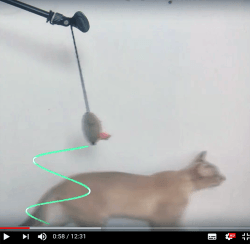Additive Analogue Synthesis: another way of looking at it
on

A few weeks ago, I posted here an amazing video by Jerobeam Fenderson. This virtuoso of Lissajous figures injects sound signals into an oscilloscope in XY mode to obtain astounding animated images on the screen. It’s not an exaggeration to say that in doing so he has elevated phase shift to an art form.
For lovers of analogue sound synthesis, this principle is rich in hitherto unforeseen possibilities thanks to programming tools like PureData, Ableton Live, Max, etc. and impossible without these digital applications.
A trigonometric mouse
I want to revisit this today to look at the teaching potential of these manipulations. This is particularly evident in the 4th episode of a series of video tutorials started by Jerobeam Fenderson several months ago. Its exact title is Oscilloscope Music Tutorial 4: Sinewaves (Harmonic Oscillation, Unit Circle, Additive Synthesis). Looking at the angle of the cat and mouse (0:52 onwards), the first contact with trigonometry becomes child’s play. The moment where the artist pivots the cosine to superimpose it on the sine (2:25) is worth any amount of abstract explanation.
From around 3:00, he skillfully introduces the subject of additive synthesis, with the empirical passage from a sinusoidal wave to a square wave (or maybe a potato-shaped one…). Isn’t this a great way of teaching this? I know that the spoken explanations, while well prepared and carefully read by the author, are fairly densely packed and delivered at a high speed. So go back to them if you need to, perhaps after trying it yourself, because that’s the purpose of this exercise.
Visual artifacts of digital compression
Episode 3 and its explanations, devoted to subtractive synthesis, didn’t convince me. So I recommend that you go back and watch episode 2 again. Notably because he shows how digital compression of an audio signal (as an MP3 for example) affects the image traces, even before this degradation is perceptible to the ear, if it ever is. Of equal importance is the passage on the effects of aliasing (artifacts of digitalization).
Even if all this stuff is already familiar to you, the approach taken here by JF is really original, because he shows on the oscilloscope screen the live signals that you normally only see on paper.


Discussion (0 comments)